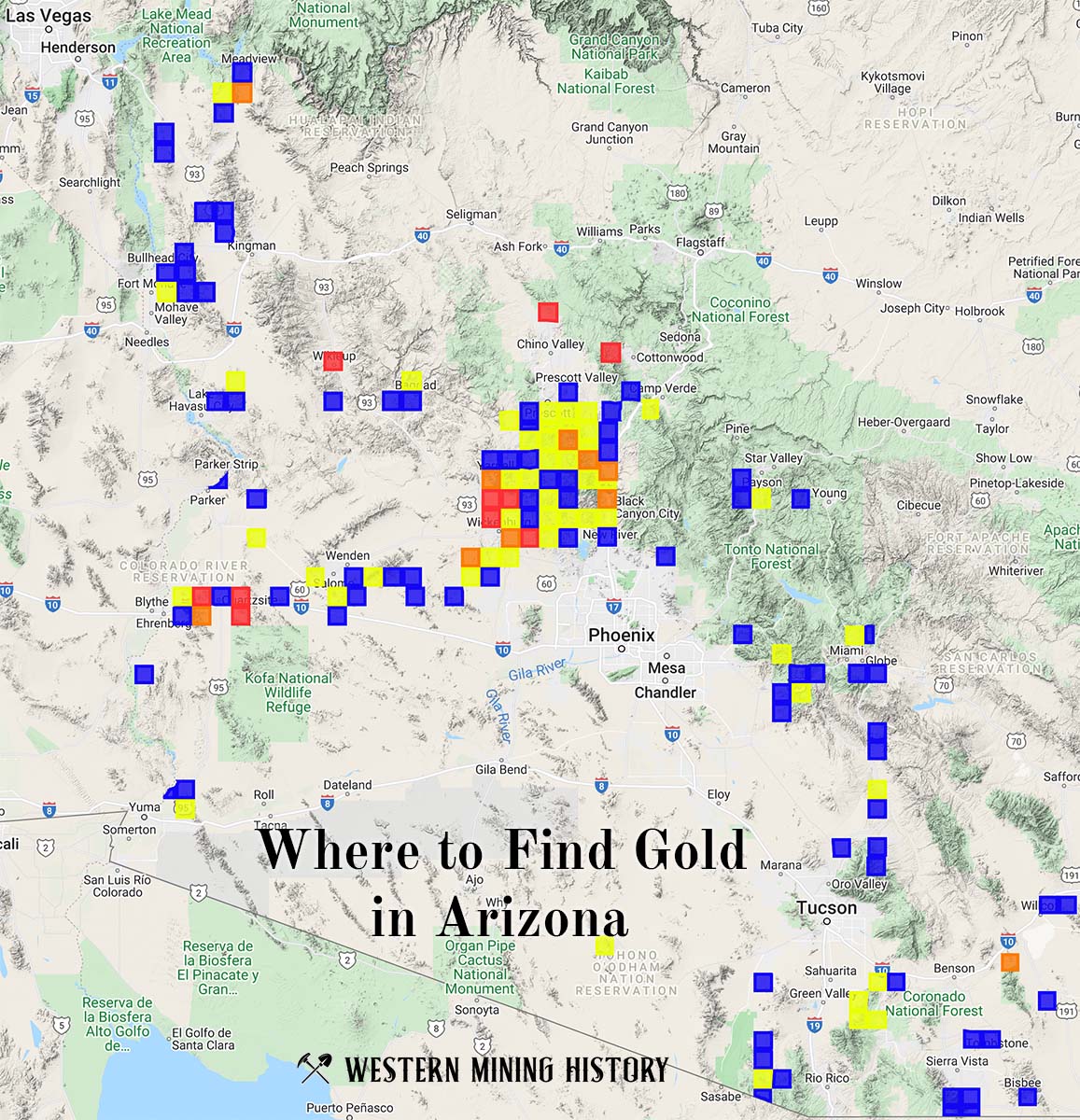The Pioneer Mine is a silver and gold mine located in Mohave county, Arizona at an elevation of 2,402 feet.
About the MRDS Data:
All mine locations were obtained from the USGS Mineral Resources Data System. The locations and other information in this database have not been verified for accuracy. It should be assumed that all mines are on private property.
Mine Info
Elevation: 2,402 Feet (732 Meters)
Commodity: Silver, Gold
Lat, Long: 35.01861, -114.40667
Map: View on Google Maps
Mine Description
The Pioneer mine, formerly known as the German-American, is about 1.5 miles southwest of Oatman.
In 1902, the Gold Road Company did some development work on this property. During 1903-1906, the German-American Mining Company produced 2,700 tons of ore that averaged about $10 in gold per ton. Some production was made by lessees in 1925, 1930, and 1932.
The Pioneer vein strikes N. 13° W., and dips 800 E. Its hanging wall is Oatman andesite and its foot wall for 2,000 feet is Alcyone trachyte. The vein intersects the Gold Dust-Boundary Cone fault zone at an angle of about 400, but neither vein shows offsetting by the other. Near the Pioneer shaft, the vein has its maximum width of about 18 feet. There, it consists of coarse-grained, gray calcite and quartz that are of rather low grade except in iron-stained zones of crushing.
Several small ore bodies were mined towards the southern end of the Pioneer vein. One of them, near the Treadwell shaft, was about 400 feet long by a maximum of 3.5 feet wide, but terminated abruptly near the 400 level Specimens of this ore consist of quartz and un replaced calcite, with some fourth-stage, greenish quartz.
North of the Thirty-fifth Parallel shaft, a shoot about 200 feet long by 3 feet wide yielded iron-stained ore from near the surface.
Near the Pioneer shaft, at the northern end of the property, narrow portions of the vein assay more than $10 per ton and yielded some relatively rich ore from near the surface.
Source: Arizona Lode Gold Mines and Gold Mining, Bulletin137, Arizona Bureau of Mines. Revised 1967
Pioneer Mine MRDS details
Site Name
Primary: Pioneer Mine
Secondary: Pioneer Vein
Secondary: German-American Vein
Secondary: Treadwell Group
Commodity
Primary: Silver
Primary: Gold
Secondary: Lead
Tertiary: Molybdenum
Location
State: Arizona
County: Mohave
District: Oatman District
Land Status
Land ownership: Private
Note: the land ownership field only identifies whether the area the mine is in is generally on public lands like Forest Service or BLM land, or if it is in an area that is generally private property. It does not definitively identify property status, nor does it indicate claim status or whether an area is open to prospecting. Always respect private property.
Holdings
Not available
Workings
Type: Underground
Ownership
Not available
Production
Year: 1942
Time Period: 1934-1942
Material type: PB
Description: Cp_Grade: ^0.007% Pb
Year: 1942
Time Period: 1934-1942
Material type: ORE
Description: Cp_Grade: ^0.007% Pb, 0.33 Oz/T Au, 0.25 Oz/T Ag
Deposit
Record Type: Site
Operation Category: Past Producer
Operation Type: Unknown
Year First Production: 1896
Discovery Year: 1896
Years of Production:
Organization:
Significant: N
Deposit Size: S
Physiography
General Physiographic Area: Intermontane Plateaus
Physiographic Province: Basin And Range Province
Physiographic Section: Mexican Highland
Mineral Deposit Model
Not available
Orebody
Not available
Structure
Type: R
Description: Nnw To Wnw Trending Vein And Fault System In Tert Volcanic Rocks
Type: L
Description: Nnw Fault Cutting Across Nw Fissure Zone Of Leland-Gold Dust-Bound Ary Cove Veins
Alterations
Alteration Type: L
Alteration Text: Silicified
Rocks
Name: Trachyte
Role: Host
Age Type: Host Rock
Age Young: Pliocene
Analytical Data
Analytical Data: $40/T AU IN 1931
Materials
Ore: Gold
Ore: Wulfenite
Gangue: Quartz
Comments
Comment (Deposit): SEVERAL SMALL ORE BODIES WERE MINED TOWARDS THE SOUTH END OF THE PIONEER VEIN: THE LARGEST WAS 400 FT LONG, 3.5 FT WIDE, THE ORE SHOOT STOPPED JUST ABOVE THE 400 FT LEVEL, ASSAYED UP TO $35/T; A SMALLER SH OOT ABOUT 200 FT LONG, 3 FT WIDE OCCURRED NEAR THE SURFACE.
Comment (Reserve-Resource): ALL ORE BODIES WERE EXHAUSTED ABOVE THE 400 FT LEVEL; THE ORE WAS C UT OFF BY A FAULT
Comment (Workings): THERE WERE 3 SHAFTS IN 1923. TOPO MAP SHOWS 16 SHAFTS ALONG VEIN
Comment (Deposit): THIS REPORT REPRESENTS A MERGER OF ORIGINAL RECORD M004486 WITH RE CORD M030384 OF JAN WILT IN MOLYBDENUM FILE; CONTACT PERSON T.G. THEOD ORE, USGS ; INFO.SRC : 1 PUB LIT; 2 UNPUB REPT
References
Reference (Deposit): GARDNER, 1936, USBM IC 6901, P. 36
Reference (Deposit): SCHRADER, 1909, USGS BULL 397, P. 186
Reference (Deposit): LAUSEN, 1931, ABM BULL 131, P. 109
Reference (Deposit): RANSOME, 1923, USGS BULL 743
Reference (Production): SCHRADER, 1909, P. 187; USBM IC 6901
Reference (Reserve-Resource): RANSOME, 1923
Arizona Gold

"Where to Find Gold in Arizona" looks at the density of modern placer mining claims along with historical gold mining locations and mining district descriptions to determine areas of high gold discovery potential in Arizona. Read more: Where to Find Gold in Arizona.